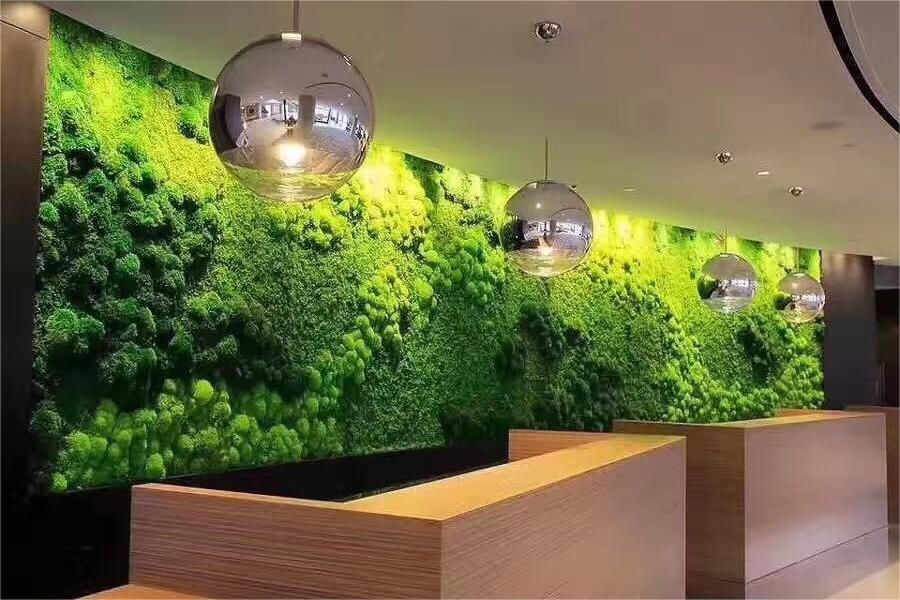What Are the Benefits of Green Walls in the Workplace?
- Annie Zhang

- Sep 17
- 4 min read

When companies invest in office renovations, two priorities consistently rise to the top: creating a healthier environment for employees and demonstrating a commitment to sustainability. Yet, many design teams struggle to find solutions that deliver both without creating ongoing maintenance headaches. This is where green walls, also known as living walls or vertical greenery, come into play.
A well-designed green wall is not just an aesthetic feature. It has measurable impacts on air quality, acoustics, employee performance, and even corporate image. For project managers, architects, and office fit-out specialists, understanding these benefits is key to making informed design decisions.
Index:
1. Cleaner Indoor Air
Plants naturally absorb carbon dioxide and release oxygen, but their benefits in an office environment go further. Studies have shown that certain species can reduce volatile organic compounds (VOCs) and airborne particulates, two common culprits in poor indoor air quality. For offices in dense urban areas, this can make a measurable difference in employee comfort and health.
If air quality is a client priority, green walls can be positioned near communal areas or high-traffic zones where circulation is most critical. For design firms, this is an effective way to align with WELL Building Standards or LEED certifications.
2. Better Employee Well-being
The concept of biophilic design—integrating natural elements into built environments—has become a defining trend in workplace design. Exposure to greenery is proven to reduce stress levels, stabilize mood, and improve overall satisfaction. Employees working in offices with natural elements consistently report higher levels of engagement.
For stakeholders overseeing office refurbishments, this translates into tangible value: fewer complaints about workplace comfort and stronger employee retention.
Looking for a cost-efficient way to bring biophilic design into your next project? Contact us at sales@sweetie-group.com to explore preserved moss green wall solutions.

3. Higher Productivity and Focus
Noise, distraction, and fatigue are three major barriers to workplace performance. A strategically placed green wall contributes on all fronts. Visually, greenery creates a calming effect, helping employees focus. Physiologically, improved air quality reduces headaches and fatigue. Psychologically, a well-designed environment signals that the employer values wellness, which has been linked to higher motivation.
4. Noise Reduction
In open-plan offices, noise pollution is one of the most common complaints. Unlike flat walls, vertical greenery has a three-dimensional structure that helps absorb sound waves. While it does not replace acoustic panels, it can significantly reduce background noise, especially in reception areas, meeting rooms, and shared workspaces.
5. Energy Efficiency and Climate Control
Living walls play a role in regulating temperature and humidity. Through evapotranspiration, plants naturally cool the surrounding air, reducing reliance on HVAC systems during warmer months. At the same time, they add humidity to overly dry office environments, reducing discomfort such as dry eyes and throat irritation.
6. Stronger Corporate Image
Clients, partners, and potential employees form impressions the moment they walk into an office. A green wall sends a clear message: this company invests in sustainability, innovation, and employee well-being. For organizations working toward ESG reporting or sustainability targets, green walls provide a visible and meaningful step in the right direction.
7. Reduced Absenteeism
A healthier workplace environment directly correlates with fewer sick days. Cleaner air, reduced stress, and better humidity balance can help reduce respiratory issues, headaches, and fatigue. While this benefit is often overlooked, it directly impacts a company’s bottom line by improving workforce stability.
8. Compliance and Certifications
Green walls can contribute credits toward LEED, BREEAM, and WELL certifications. For design firms, this adds another tool to strengthen project proposals. By incorporating vertical greenery, you not only enhance the workspace but also align the building with globally recognized sustainability standards.

Preserved Moss: A Practical Alternative
Traditional living walls deliver clear benefits, but they also come with challenges: irrigation systems, specialized lighting, and ongoing maintenance contracts. This is where preserved moss walls offer a smart alternative.
Preserved moss is real, natural moss that has been treated to maintain its color, texture, and softness for years—without the need for watering or sunlight. It offers many of the same advantages as a living wall, with far lower upkeep requirements.
Here is a quick comparison:
For offices where long-term maintenance budgets are a concern, preserved moss walls provide a practical solution that still supports biophilic design principles.
If you’re considering a green wall but want to avoid complex maintenance, email sales@sweetie-group.com for preserved moss wall design options tailored to your space.
Design and Installation Considerations
Before recommending a green wall, consider:
Placement: Near natural light sources for living walls, or anywhere for preserved moss walls.
Structural load: Ensure the wall can support the installation weight.
Integration: Combine with brand colors or company logos for maximum impact.
Regulatory compliance: Verify local building codes, especially around fire safety and water systems.
These details often determine whether a project succeeds smoothly or runs into complications. Engaging with suppliers early can help you align design intent with technical feasibility.
Need a feasibility review for your project? Reach out at sales@sweetie-group.com to get expert input before installation begins.
Final Thoughts
Green walls are more than decorative features. They improve indoor air quality, enhance employee well-being, reduce noise, regulate climate, and strengthen corporate image—all while supporting sustainability goals. For workplaces that demand a balance of aesthetics and practicality, preserved moss walls offer an equally effective but far simpler alternative.
When planned and executed correctly, a green wall is not just an addition to the office—it becomes a long-term investment in healthier, more productive, and more inspiring workplaces.

CEO of Sweetie-Group









Comments